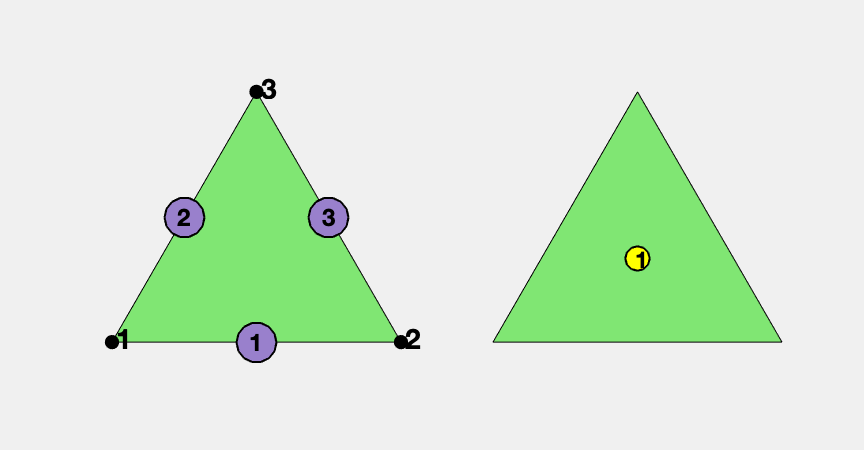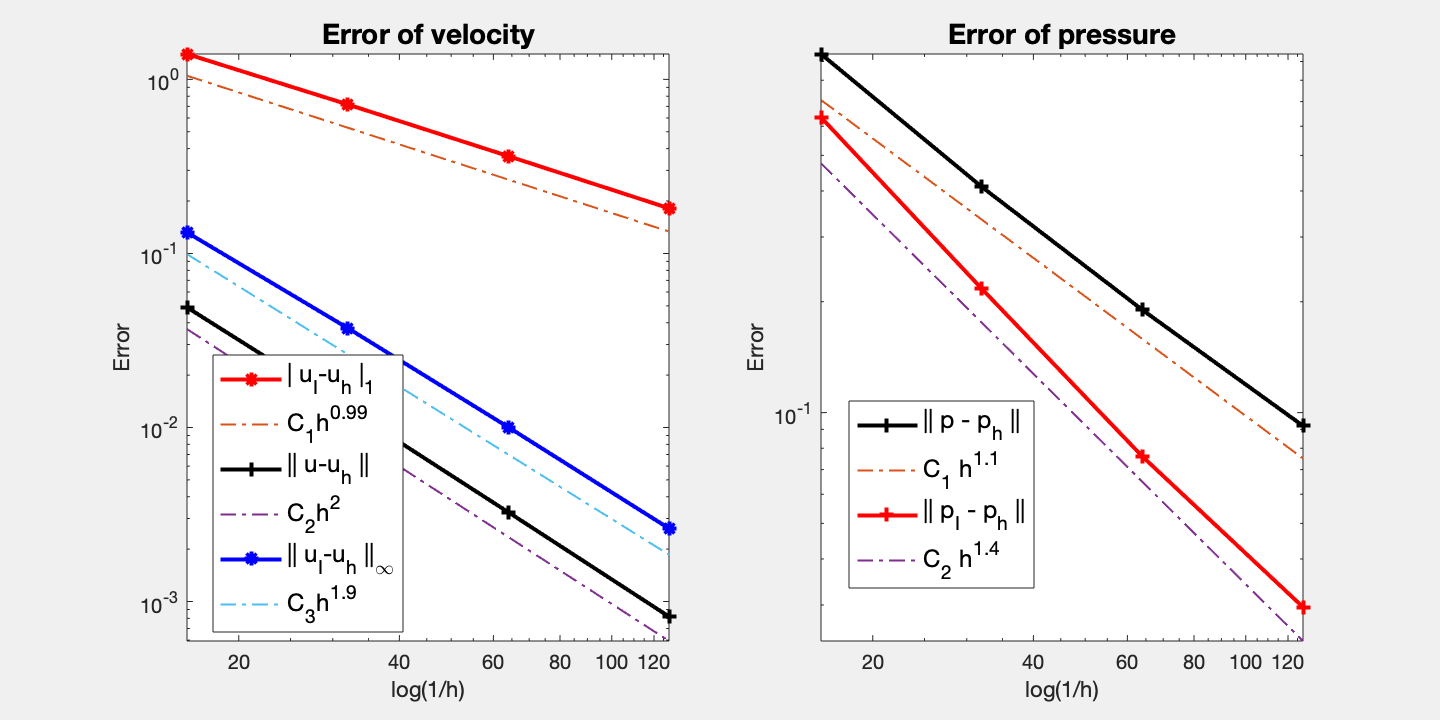CR-P0 Finite Elements for Stokes Equations
This example is to show the convergence of CR-P0 finite elements for the Stokes equation on the unit square:
\[- \Delta u + {\rm grad}\, p = f \quad {\rm div}\, u = 0 \quad \text{ in } \quad \Omega,\]with the pure Dirichlet boundary condition. The solver is based on a DGS type smoother.
References:
Subroutines:
- StokesCRP0
- squareStokes
- femStokes
- StokesCRP0femrate
The method is implemented in StokesCRP0 subroutine and can be tested in squareStokes. Together with other elements (P2P0, P2P1, isoP2P0, isoP2P1, P1bP1), femStokes provides a concise interface to solve Stokes equation. The CR-P0 element is tested in Stokesfemrate.
CR-P0 element
The velocity is CR non-conforming linear element and the pressure is P0 piecewise constant element.
We list the basis for CR below and refer to PoissonCRfemrate for detailed data structure for CR element.
The 3 Lagrange-type bases functions are denoted by $\phi_i, i=1:3$, i.e. $\phi_i(m_j)=\delta _{ij},i,j=1:3$, where $m_i$ is the middle point of the i-th edge. In barycentric coordinates, they are:
\[\phi_i = 1- 2\lambda_i,\quad \nabla \phi_i = -2\nabla \lambda_i,\]Since the unknowns are associated to edges, we need to generate edges and the indices map from a triangle to global indices of its three edges. The edges are labled such that the i-th edge is opposite to the i-th vertex for i=1,2,3.
clear all;
imatlab_export_fig('print-png') % Static png figures.
node = [0,0; 1,0; 0.5, sqrt(3)/2];
elem = [1, 2, 3];
[elem2edge,edge] = dofedge(elem);
set(gcf,'Units','normal');
set(gcf,'Position',[0.25,0.25,0.3,0.25]);
subplot(1,2,1); showmesh(node,elem); findnode(node); findedge(node,edge);
subplot(1,2,2); showmesh(node,elem); findelem(node,elem);
display(elem2edge)
elem2edge =
1x3 uint32 row vector
3 2 1

Dirichlet boundary condition
%% Setting
% mesh
[node,elem] = squaremesh([0,1,0,1],0.25);
[node,elem] = uniformrefine(node,elem);
bdFlag = setboundary(node,elem,'Dirichlet');
mesh = struct('node',node,'elem',elem,'bdFlag',bdFlag);
% pde
pde = Stokesdata1;
% options
option.L0 = 0;
option.maxIt = 4;
option.printlevel = 1;
option.solver = 'mg';
option.elemType = 'CRP0';
femStokes(mesh,pde,option);
#dof: 1984, #nnz: 9280, level: 3 MG WCYCLE iter: 9, err = 6.7087e-09, time = 0.11 s
#dof: 8064, #nnz: 38016, level: 4 MG WCYCLE iter: 9, err = 6.8886e-09, time = 0.15 s
#dof: 32512, #nnz: 153856, level: 5 MG WCYCLE iter: 9, err = 7.2684e-09, time = 0.51 s
#dof: 130560, #nnz: 619008, level: 6 MG WCYCLE iter: 9, err = 7.4799e-09, time = 2.4 s
Table: Error
#Dof h |u_I-u_h|_1 ||u-u_h|| ||u_I-u_h||_{max}
2112 6.25e-02 1.39954e+00 4.90098e-02 1.32091e-01
8320 3.12e-02 7.18220e-01 1.28301e-02 3.72726e-02
33024 1.56e-02 3.62378e-01 3.25995e-03 1.00379e-02
131584 7.81e-03 1.81727e-01 8.19377e-04 2.63052e-03
#Dof h ||p_I-p_h|| ||p-p_h||
2112 6.25e-02 6.34277e-01 9.42925e-01
8320 3.12e-02 2.17142e-01 4.10772e-01
33024 1.56e-02 7.60130e-02 1.90168e-01
131584 7.81e-03 2.96038e-02 9.20441e-02
Table: CPU time
#Dof Assemble Solve Error Mesh
2112 6.00e-02 1.10e-01 5.00e-02 0.00e+00
8320 1.00e-02 1.50e-01 2.00e-02 0.00e+00
33024 5.00e-02 5.10e-01 5.00e-02 1.00e-02
131584 1.10e-01 2.38e+00 2.40e-01 1.00e-02


Conclusion
Optimal order convergence of velocity and pressure is observed. First order for velocity in H1 norm and for pressure in L2 norm. Second order for velocity in L2 and maximum norm. For pressure, half order superconvergence when compare to interpolate.
Multigrid solver based on DGS smoother converges uniformly.
To-Do: test other boundary conditions.
Comments